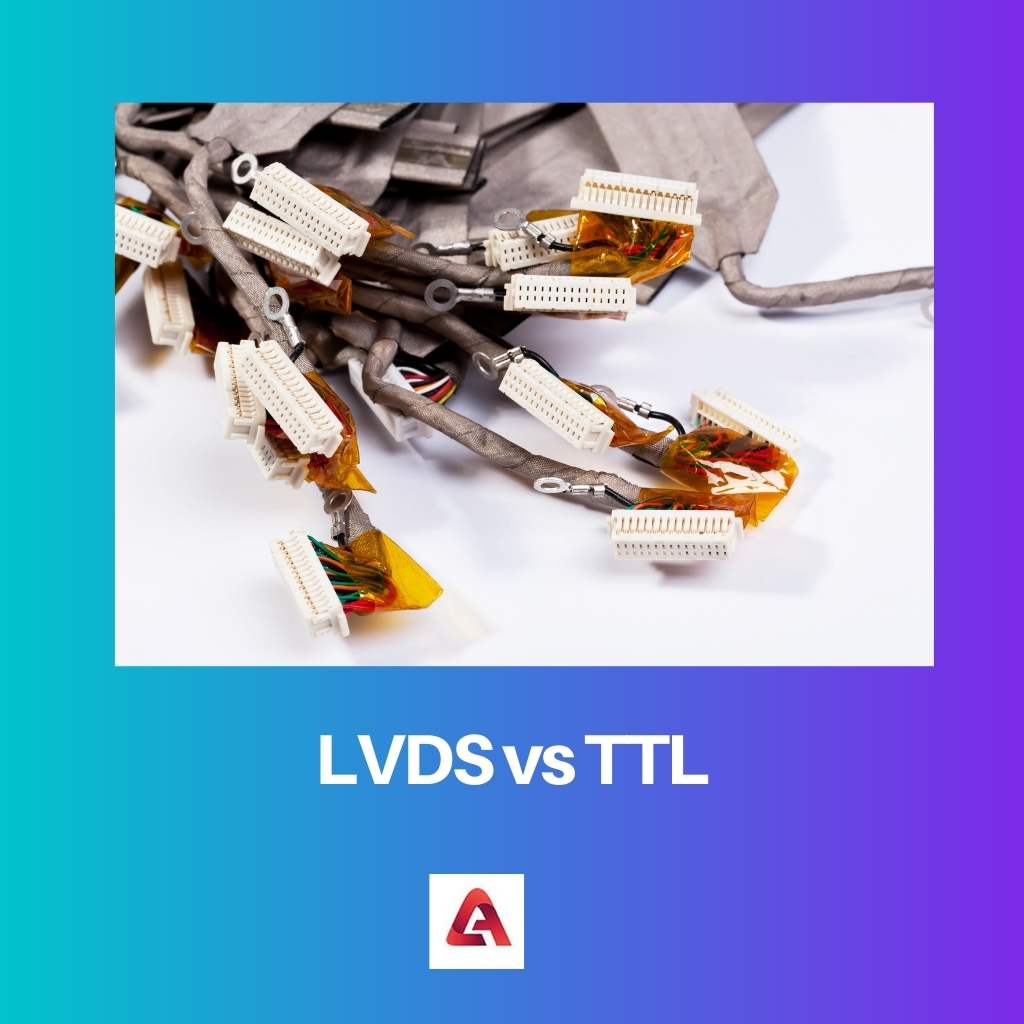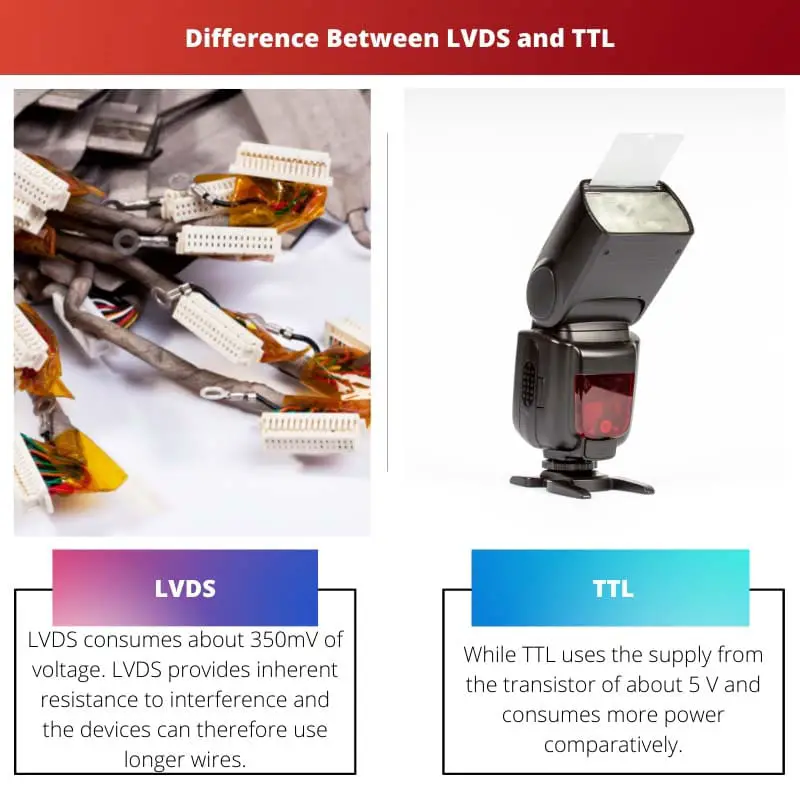The method of electrically transmitting Information using two complementary signals is called differential signalling.
This is the technique that is capable of sending similar electrical signals, in the form of differential pairs, in its conductors. Differential signalling is used widely in two types of communication schemes. They are LVDS and TTL.
Key Takeaways
- LVDS (Low Voltage Differential Signaling) is a low-power, high-speed data transmission method, while TTL (Transistor-Transistor Logic) is a family of integrated digital logic circuits.
- LVDS consumes less power and is less susceptible to noise, making it suitable for high-speed data transfers, whereas TTL is used for lower-speed applications.
- TTL has a simpler design, but LVDS offers better signal integrity and improved performance in high-speed applications.
LVDS vs TTL
Low-voltage differential signalling (LVDS) is a technical standard unit that distinguishes electrical characteristics like differential signalling. It operates on low power and requires twisted copper cables to run at high speed. It is popularly used in LCD, car entertainment, computers and communication systems. Transistor-transistor logic (TTL) uses a high power consumption, which performs logic and amplifying functions.

LVDS consumes about 350mV of voltage. LVDS provides inherent resistance to interference, and the devices can, therefore, use longer wires.
LVDS uses twisted copper pairs that create high electromagnetic field coupling. They can stabilize voltage spikes. Unlike TTL, the three reference point of LVDS is not the ground.
While TTL uses the supply from the transistor of about 5 V and consumes more power comparatively.
TTL does not provide inherent resistance and hence cannot stabilize voltage spikes, which can result in an error of binary results. Since the mode of transmission is parallel, it requires separate wires and increases the number of wires.
Comparison Table
| Parameters of Comparison | LVDS | TTL |
|---|---|---|
| Distance of transmission | Higher distance of transmission | Lower distance of transmission |
| Mode of transmission | Serial mode | Parallel mode |
| Power consumption | Low power consumption | High power consumption |
| Reference point | No usage of the ground system for reference signal | Uses ground as the reference signal |
| Application | In high-speed backplane, transmissions like cabled, board or clock distribution and widely in parts of communication and infotainment devices | Serial storage architecture (SSA) devised by IBM |
What is LVDS?
LVDS stands for Low-Voltage Differential Signalling. It is a standard unit that is used to differentiate specific electrical characteristics like serial or differential signalling.
It is commonly misunderstood as a protocol. LVDS requires low power and high speed to operate and consists of twisted copper cables. It is also used as a data link layer on the top of the OSI model.
LVDS was discovered in 1994 by the National Semiconductor but gained popularity in the 1990s.
It is mainly used as a standard for high-speed data transfer in infotainment systems like LCD TVs, computers, tablets, video cameras, and other communication systems.
Earlier among the engineers, the term LVDS was mistaken as synonymous with Flat Panel Display Link (FPD-Link). The computer monitor resolutions before the invention of LVDS lacked faster rates for graphics and videos.
The first application of LVDS was in 1992 when Apple Computer collaborated with National Semiconductor and developed QuickRing. It was an auxiliary bus for high-speed video data.
Currently, LVDS is used to replace PECL (Positive Emitter-Coupled Logic) in interconnecting multiprocessing systems.
LVDS devices without signal conditioning can receive equalization and transmission up to several meters (about 16-20 meters) and offer a speed of less than equal to 155.5 Mbps in a low-power general interface.
What is TTL?
TTL stands for Transistor-transistor logic. It is installed in electronic devices to be resistant to noise. TTL is single-ended. The reference of TTL is system ground.
The voltage level can go as low as 0-0.8 volts and as high as 2-5 volts. TTL follows a similar principle as that of LVDS but operates on different levels of voltage.
TTL is used in long-distance signalling. It is efficient in the removal of unwanted voltage induced, and only the voltage from the driver’s side remains. The differential type of TTL can form a current loop in the pair of wires.
There is no current exchange that occurs between the receiver and the driver, and the signal current needs to return to the ground connection.
The logic used in TTL is binary coding with the presence or absence of voltage. The reference is the ground system, which determines the binary, whether 1 or 0.
TTL faces voltage spikes during data transmission, so it provides faulty binary values. TTL also does not use lower voltage levels.
TTL follows a parallel mode of transmission. Its mode of transmission requires a longer and greater number of wires. It cannot support a higher distance of transmission. TTL also does not provide methods of lowering voltage levels.
Main Differences Between LVDS and TTL
- The full form of LVDS is Low Voltage Differential Signalling, while the full form of TTL is Transistor-transistor Logic.
- Devices that use LVDS have a longer and larger number of wires, while devices that use TTL have a shorter and smaller number of wires.
- LVDS uses lower voltage levels, while TTL uses higher voltage levels.
- LVDS is created to be more resistant to interference, while TTL is not resistant to interference.
- LVDS transmits information in serial mode and can congregate several signals into one, while TTL transmits information in parallel mode.

- https://literature.cdn.keysight.com/litweb/pdf/5988-4797EN.pdf
- http://www.hep.ucl.ac.uk/~mp/ELECTRONICS/LVDS_Techn_App_note_AN-971.pdf

The technical details about voltage levels and modes of transmission provide a complex yet thorough look at LVDS and TTL. This level of detail is excellent for engineers.
The depth of information in this article is impressive.
I agree, it provides a deep dive into these technologies.
This is an effective technological tool to engage in. The high speed and low power consumption make LVDS a highly effective data transmission method.
I agree, the potential for high-speed data transmission is very appealing.
The section comparing LVDS and TTL is comprehensive and informative. It provides practical insights for engineers.
The clear explanation of LVDS and TTL is helpful for those new to this technology. It’s an accessible introduction to these concepts.
Absolutely, this article is a great starting point for understanding LVDS and TTL.
I appreciate how approachable the content is for those learning about LVDS and TTL.
This article provides valuable insight into the historical and current applications of LVDS and TTL. It’s an excellent overview of these technologies.
The historical context of LVDS is particularly interesting. It’s valuable to understand the trajectory of this technological innovation.
While it’s clear that LVDS offers many advantages, the article also highlights the benefits of TTL in specific contexts. It’s important to consider the unique strengths of each method.
Absolutely, this balanced perspective is essential for evaluating engineering solutions.
I’m glad the article acknowledges the value of both LVDS and TTL.
The comparison table provides a clear and concise overview of the differences between LVDS and TTL. This is helpful for understanding the practical applications of each.
I appreciate the thorough breakdown of the comparison.
Absolutely, it’s a great resource for engineering applications.